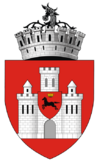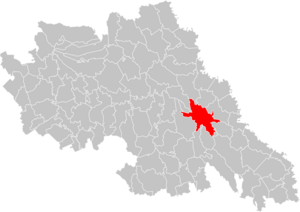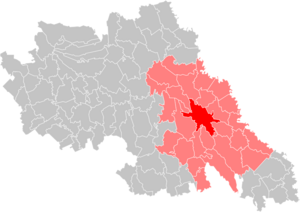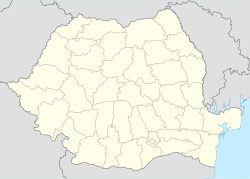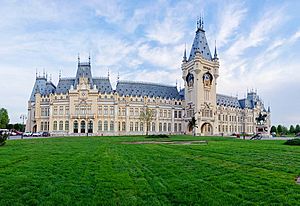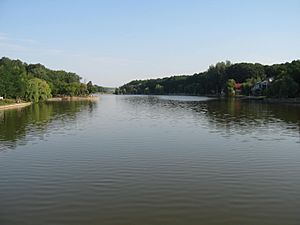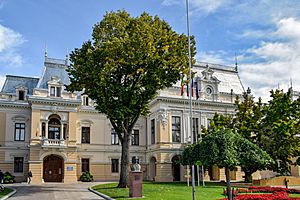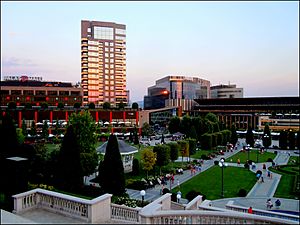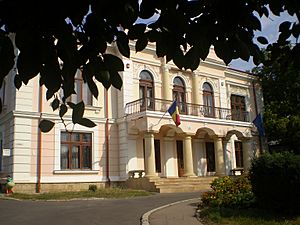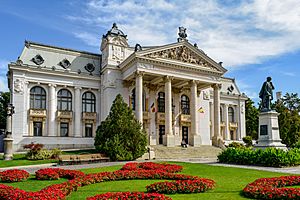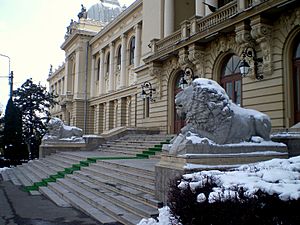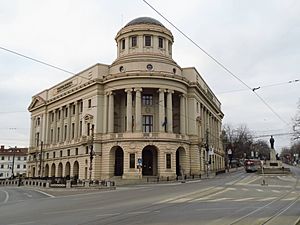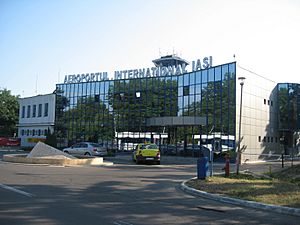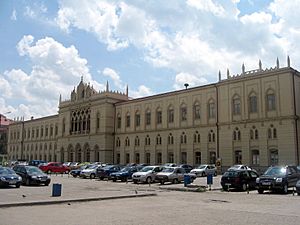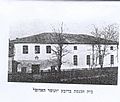Iași facts for kids
Quick facts for kids
Iași
|
||
|---|---|---|

From top left:
Palace of Culture • Vasile Alecsandri Statue in front of the National Theatre • Alexandru Ioan Cuza University • Golia Tower • Metropolitan Cathedral • Botanical Garden |
||
|
||
| Nickname(s):
The City of Great Loves, The City of the Famous Destinies, The City of Great Ideas, The City of the Three Unions, The City on Seven Hills
|
||
|
Location of Iași inside Iași County
|
||
| Country | ||
| County | Iași | |
| Status | County seat | |
| Settled | Before 14th century | |
| First official record | 1408 | |
| Area | ||
| • City | 93.9 km2 (36.3 sq mi) | |
| • Metro | 1,159 km2 (447 sq mi) | |
| Elevation | 60 m (200 ft) | |
| Population
(2021)
|
||
| • City | 271,692 | |
| • Density | 2,894/km2 (7,500/sq mi) | |
| • Metro | 423,154 | |
| Time zone | UTC+2 (EET) | |
| • Summer (DST) | UTC+3 (EEST) | |
| Postal Code |
700xxx
|
|
| Area code(s) | +40 x32 | |
| Car Plates | IS | |
| Climate | Dfb | |
Iași (pronounced YASH-ee) is a big city in Romania. It's the third largest city in the country and the main city of Iași County. Iași is located in the historical region of Moldavia. It has always been a very important place for Romanian culture, learning, and art.
For many years, Iași was the capital city. It was the capital of the Principality of Moldavia from 1564 to 1859. Then, it was the capital of the United Principalities from 1859 to 1862. During World War I, it even served as Romania's capital from 1916 to 1918.
Iași is often called the "Cultural Capital of Romania." It's a key symbol of Romanian history. A famous historian, Nicolae Iorga, once said that "there should be no Romanian who does not know of it." Today, Iași is the main center for business and economy in Romania's Moldavian region. In 2018, it was officially named the Historical Capital of Romania.
In 2021, the city had about 271,692 people living in it. If you count the surrounding areas, the population is much larger, with over 500,000 people.
Iași is home to the oldest university in Romania and the first engineering school. This makes it a very important place for education and research. Over 60,000 students study here at five public universities. The city's cultural life is busy with the Vasile Alecsandri National Theatre (the oldest in Romania), the Moldova State Philharmonic, and the Opera House. You can also visit the Botanical Garden, which is the oldest and largest in Romania. Every October, Iași hosts the biggest Christian pilgrimage in Romania.
Contents
- What's in a Name? The Story of Iași's Name
- A Journey Through Time: The History of Iași
- Exploring Iași: Geography and Climate
- City Sights: Architecture and Buildings in Iași
- People of Iași: Demographics
- Working in Iași: The Economy
- Culture and Arts: The Heart of Iași
- Learning in Iași: Education
- Sports in Iași
- Getting Around: Transport in Iași
- Monuments and History: Statues and Memorials
- Global Connections: Twin Towns
- Consulates in Iași
- Famous People from Iași
- Images for kids
- See also
What's in a Name? The Story of Iași's Name
Many experts have ideas about where the name "Iași" comes from. Some think it comes from an ancient group called the Iazyges. These people were mentioned by a poet named Ovid a long time ago.
Another idea is that the name comes from an Iranian group called the Jassi. They are thought to be related to the Yazyges tribes. In the past, the Prut river was even called Alanus fluvius, and the city was known as Forum Philistinorum.
The Hungarian name for the city is Jászvásár, which means "Jassic Market." This suggests that Iași was a busy market town. The old Romanian name, Târgul Ieșilor, also means "Market of the Iasians."
A Journey Through Time: The History of Iași
Early Settlements: Iași's Ancient Roots
Archaeological digs show that people lived in the Iași area a very long time ago, even in prehistoric times. Later, settlements from the 6th to 10th centuries have been found. These early homes had rectangular shapes and special ovens. Many old pots found from the 9th–11th centuries had crosses on them. This might mean the people living there were Christians.
Growing Up: Iași's First Mentions
The city of Iași was first officially written about in 1408. This was in a document where Prince Alexander gave special trading rights to Polish merchants. However, there are buildings in Iași that are older than 1408, like the Armenian Church, which might have been built in 1395. This tells us the city was around even before it was first written down.
Capital City: Iași Leads Moldavia
Around 1564, Prince Alexandru Lăpușneanu moved the capital of Moldavia from Suceava to Iași. This made Iași a very important city. In 1640, Vasile Lupu started the first school where Romanian was taught instead of Greek. He also set up a printing press at the Trei Ierarhi Monastery. In 1643, the first book ever printed in Moldavia was published in Iași.
Over the years, Iași faced many challenges. It was sometimes attacked and looted by different groups. It also suffered from natural disasters like the plague in 1734 and big fires.
A peace treaty, called the Treaty of Jassy, was signed here in 1792. This treaty ended a war between Russia and Turkey.
Modern Times: Iași in the 19th and 20th Centuries
Between 1564 and 1859, Iași was the capital of Moldavia. Then, from 1859 to 1862, both Iași and Bucharest were capitals of the newly united regions of Moldavia and Wallachia. In 1862, when Romania was officially formed, Bucharest became the only capital.
During World War I, Iași became the capital of Romania again for two years (1916-1918). This happened after Bucharest was taken over by enemy forces.
The Jewish Community: A Rich History in Iași
Iași has a long and important history for its Jewish community. The first Jewish people arrived here in the late 1500s. By the mid-1800s, a large part of the city's population was Jewish.
In 1855, the first Yiddish-language newspaper, Korot Haitim, was published in Iași. In 1876, the first professional Yiddish theater show took place here. The words of "HaTikvah", which is now the national anthem of Israel, were written in Iași by Naftali Herz Imber. Jewish musicians in Iași also helped keep Yiddish culture alive through their music.
By 1930, over 34,000 Jewish people lived in Iași, making up about 34% of the city. There were more than 127 synagogues (Jewish places of worship).
Sadly, during World War II, a terrible event known as the Iași pogrom happened in June 1941. Thousands of Jewish people were killed or deported. This was a very dark time in the city's history.
After World War II, many Jewish people moved to Israel. Today, Iași has a smaller Jewish community, with about 300 to 600 members. Two synagogues are still active, including the Great Synagogue, which was built in 1671. It is the oldest surviving synagogue in Romania and one of the oldest in Europe. It was recently restored and reopened in 2018.
After World War II: Growth and Change
After World War II, Iași grew a lot. Many factories were built, and more people moved to the city from the countryside. The city's area also expanded. By 1989, Iași had many large factories, making things like machines, chemicals, textiles, and electronics.
After the end of the Communist era in Romania, many of the old factories closed. However, new private businesses started to grow.
Exploring Iași: Geography and Climate
Iași's Landscape: Hills and Rivers
Iași is located in northeastern Romania, where two plains meet. It used to be a busy place where trade routes from different countries crossed.
The city sits in the valley of the Bahlui River, which flows into the Jijia River. The area around Iași has many hills and forests, with monasteries and parks. Iași itself is surrounded by vineyards and gardens.
Many people believe that Iași is built on seven hills, just like Rome. These hills are Breazu, Bucium, Cetățuia, Copou, Galata, Repedea, and Șorogari.
Weather in Iași: Four Seasons
Iași has four clear seasons. Summers are warm, with temperatures sometimes going above 35°C (95°F). Winters are cold and windy, with snow. Night temperatures can drop below -15°C (5°F).
| Climate data for Iași, Romania (Iași International Airport) (1991–2020, extremes 1896-2020) | |||||||||||||
|---|---|---|---|---|---|---|---|---|---|---|---|---|---|
| Month | Jan | Feb | Mar | Apr | May | Jun | Jul | Aug | Sep | Oct | Nov | Dec | Year |
| Record high °C (°F) | 16.7 (62.1) |
22.5 (72.5) |
27.0 (80.6) |
31.8 (89.2) |
36.4 (97.5) |
38.0 (100.4) |
40.1 (104.2) |
41.3 (106.3) |
38.0 (100.4) |
33.9 (93.0) |
29.0 (84.2) |
19.5 (67.1) |
41.3 (106.3) |
| Mean daily maximum °C (°F) | 1.3 (34.3) |
3.9 (39.0) |
10.2 (50.4) |
17.5 (63.5) |
23.3 (73.9) |
27.0 (80.6) |
29.0 (84.2) |
28.8 (83.8) |
23.1 (73.6) |
16.3 (61.3) |
8.8 (47.8) |
2.8 (37.0) |
16.0 (60.8) |
| Daily mean °C (°F) | −2.1 (28.2) |
−0.3 (31.5) |
4.5 (40.1) |
11.1 (52.0) |
16.8 (62.2) |
20.7 (69.3) |
22.4 (72.3) |
21.7 (71.1) |
16.3 (61.3) |
10.4 (50.7) |
4.8 (40.6) |
−0.5 (31.1) |
10.5 (50.9) |
| Mean daily minimum °C (°F) | −5.1 (22.8) |
−3.6 (25.5) |
0.2 (32.4) |
5.6 (42.1) |
10.7 (51.3) |
14.7 (58.5) |
16.3 (61.3) |
15.6 (60.1) |
11.0 (51.8) |
6.1 (43.0) |
1.7 (35.1) |
−3.3 (26.1) |
5.8 (42.4) |
| Record low °C (°F) | −30.6 (−23.1) |
−36.3 (−33.3) |
−22.7 (−8.9) |
−9.4 (15.1) |
−3.0 (26.6) |
3.5 (38.3) |
6.3 (43.3) |
−0.5 (31.1) |
−6.7 (19.9) |
−21.1 (−6.0) |
−27.2 (−17.0) |
−29.5 (−21.1) |
−36.3 (−33.3) |
| Average precipitation mm (inches) | 27.7 (1.09) |
25.8 (1.02) |
33.5 (1.32) |
43.5 (1.71) |
59.9 (2.36) |
78.0 (3.07) |
70.8 (2.79) |
49.4 (1.94) |
49.2 (1.94) |
45.4 (1.79) |
33.0 (1.30) |
31.8 (1.25) |
548.0 (21.57) |
| Average snowfall cm (inches) | 11.3 (4.4) |
14.3 (5.6) |
11.9 (4.7) |
6.9 (2.7) |
0.0 (0.0) |
0.0 (0.0) |
0.0 (0.0) |
0.0 (0.0) |
0.0 (0.0) |
0.7 (0.3) |
10.4 (4.1) |
6.3 (2.5) |
61.8 (24.3) |
| Average precipitation days (≥ 1.0 mm) | 5.9 | 4.9 | 6.2 | 6.5 | 8.4 | 8.4 | 7.5 | 5.4 | 5.5 | 5.4 | 5.0 | 6.0 | 75.1 |
| Average relative humidity (%) | 82 | 80 | 71 | 62 | 61 | 62 | 60 | 63 | 66 | 73 | 79 | 83 | 70 |
| Average dew point °C (°F) | −5.6 (21.9) |
−4.7 (23.5) |
−0.1 (31.8) |
4.7 (40.5) |
9.6 (49.3) |
13.2 (55.8) |
14.6 (58.3) |
13.9 (57.0) |
10.6 (51.1) |
6.1 (43.0) |
2.0 (35.6) |
−2.0 (28.4) |
5.2 (41.4) |
| Mean monthly sunshine hours | 71.3 | 95.0 | 147.6 | 196.1 | 254.0 | 265.5 | 291.2 | 276.0 | 200.5 | 146.9 | 77.9 | 61.5 | 2,083.5 |
| Source 1: NOAA (snowfall and dew point 1961–1990) | |||||||||||||
| Source 2: Romanian National Statistic Institute (extremes 1901–2000), Deutscher Wetterdienst (extremes, 1896–2015 and humidity, 1896–1960) | |||||||||||||
City Sights: Architecture and Buildings in Iași
Amazing Architecture: Buildings to See
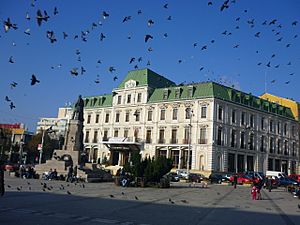
Iași has many historical buildings, some churches are 500 years old! There's also modern architecture. Many buildings are listed as national historic monuments. A famous one is the Palace of Culture. It's a beautiful neo-Gothic building, built where an old medieval palace used to be.
During World War II and the Communist era, some old buildings in the city center were destroyed. They were replaced with newer styles. In 2012, the Palas shopping mall and office complex opened near the Palace of Culture.
Here are some other important buildings:
- Alexandru Ioan Cuza University main building (1897): This building mixes old styles like Neoclassical and Baroque. It has a famous "Hall of the Lost Footsteps" with paintings by Sabin Bălașa.
- "Vasile Alecsandri" National Theatre: Built between 1894 and 1896, it's a beautiful theater with detailed decorations.
- Dosoftei House: This 17th-century building was where the second printing press in Moldavia was set up in 1679. Today, it's part of the Romanian Literature Museum.
- Roznovanu Palace (The City Hall): Built in the 18th century, this palace hosted the Romanian government during World War I.
- Union Museum: This palace was the home of Prince Alexandru Ioan Cuza from 1859 to 1862. It also served as the royal residence during World War I.
- Pogor House: Built in 1850, this house was a meeting place for writers and thinkers. It now houses the Romanian Literature Museum.
- Great Railway Station: Built in 1870, its design was inspired by the famous Doge's Palace in Venice, Italy.
Places of Worship: Churches and Monasteries
Iași is an important religious center. It's home to the head of the Romanian Orthodox Church in Moldavia and Bukovina, and the Roman Catholic Bishop of Iași. The city and nearby areas have over 10 monasteries and 100 historical churches.
- Princely Saint Nicholas (1491): This is one of the oldest churches, built during the time of Stephen the Great.
- Metropolitan Cathedral (1839/1886): This is the largest Orthodox church in Romania. It holds the relics of Saint Parascheva.
- Golia Monastery, 1564: Rebuilt in 1650, it's a huge monastery in the middle of the city, surrounded by tall walls and a 30-meter (98 ft) bell tower.
- Armenian Church, 1395: This church shows that there was an important Armenian community in Iași a long time ago.
- Great Synagogue, 1657–1671: This is the oldest surviving synagogue in Romania and one of the oldest in Europe.
Other historic churches and monasteries include Socola (1562), Galata (1582), Saint Sava (1583), and Cetățuia (1668). Many of these have old defense walls and towers.
Pilgrimage: A Special Journey
Iași has been a major Christian pilgrimage site for centuries. In 1641, the relics of Saint Parascheva were brought to Iași. Every year around October 14, hundreds of thousands of pilgrims come to honor Saint Parascheva. This October pilgrimage is one of the largest in Europe. People come from all over Romania and other Orthodox countries.
Throughout the year, people also visit many other religious sites in and around Iași.
Green Spaces: Parks and Natural Wonders
Iași has many public spaces, from city squares to beautiful parks.

Copou Park was started in 1833. It's one of Romania's first planned public parks. In the middle of the park stands the Obelisk of Lions (1834). This 13.5-meter (44 ft) tall monument is dedicated to an important old law.
The Botanical Garden of Iași, founded in 1856, was the first botanical garden in Romania. It covers over 100 hectares (247 acres) and has more than 10,000 types of plants.
Ciric Park, in the northeastern part of Iași, has parkland and four lakes.
The Eminescu's Linden Tree (Romanian: Teiul lui Eminescu) in Copou Park is about 500 years old. The famous poet Mihai Eminescu is said to have written some of his best works under this tree. It's a very important natural landmark in Romania. Another special place for Eminescu was the Odd Poplars Alley in the Bucium neighborhood. In 1973, the 15 remaining old poplars there were declared natural monuments.
Iași County has many very old trees. The oldest tree in the county is a 675-year-old linden tree at Bârnova Monastery, near Iași. This tree was already about 57 years old when Iași was first mentioned as a city in 1408!
People of Iași: Demographics
As of 2021, Iași is Romania's third largest city, with 271,692 people living in it. If you include the surrounding areas, the Iași urban area is the second largest in Romania, with about 500,668 residents (in 2018).
The Iași metropolitan area (which includes Iași and 19 nearby towns) had a population of 423,154 in 2021. Iași County is the most populated county in Romania (besides Bucharest). Also, about 60,000 students and thousands of daily commuters add to the city's population.
Most people in Iași are Romanian (98.5%). Other groups include Romani, Jews, Greeks, and Hungarians. Most people (92.5%) are Christian Orthodox. There are also almost 10,000 Roman Catholics in Iași.
Working in Iași: The Economy
Iași is a key economic center in Romania. Its economy relies on both factories and service jobs. Important service jobs are in education, healthcare, banking, research, culture, government, and tourism.
The city is a big center for information technology (IT). Many large international companies like Amazon and Oracle have offices here. There are also many local IT companies. Iași has two universities that train students for IT jobs. Experts believe the number of IT workers in Iași will grow a lot by 2030.
Many people in Iași also work in manufacturing. This includes making car parts (Delphi, Lear), medicines (Antibiotice Iași), metal products (ArcelorMittal), and clothes (Benetton).
The area around Iași is famous for its vineyards and wines. Iași is part of a traditional wine region. You can find well-known vineyards like Cotnari and Bohotin nearby.
Iași also has many large shopping malls and stores, showing it has a strong retail business.
Who Employs the Most People in Iași?
| Company | Industry | Employees |
|---|---|---|
| Sf. Spiridon University Hospital | Health care | 2,944 |
| BorgWarner | Automotive industry | 2,612 |
| Alexandru Ioan Cuza University | High education | 2,021 |
| Continental Automotive Romania | Automotive engineering | 2,000 |
| Amazon Development Center | IT services | 1,956 |
| Gheorghe Asachi Technical University | High education | 1,710 |
| AlmavivA Services | Customer services | 1,486 |
| Antibiotice Iași | Pharmaceutical industry | 1,415 |
| CTP Iași | Public transport | 1,349 |
| ApaVital | Water industry | 1,347 |
Culture and Arts: The Heart of Iași
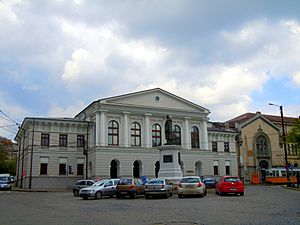
Many important events in Moldavian history and culture happened in Iași. Famous scholars like Grigore Ureche and Miron Costin wrote their works here in the 17th century. The well-known scholar Dimitrie Cantemir also had strong ties to Iași.
The first newspaper in Romanian was published in Iași in 1829. Later, in 1867, the famous Convorbiri Literare magazine was started here. This magazine published Ion Creangă’s "Childhood Memories" and poems by Mihai Eminescu.
Many great Romanian cultural figures are connected to Iași. These include poets Vasile Alecsandri and George Topârceanu, writers Mihail Sadoveanu and Alecu Russo, and literary critic Titu Maiorescu.
Theatres and Music: Performances in Iași
The Vasile Alecsandri National Theatre opened in 1840. It was the first National Theatre in Romania. The beautiful building was built between 1894 and 1896. Since 1956, it has also been home to the Iași Romanian National Opera.
Iași also has:
- Moldova State Philharmonic Orchestra
- Luceafărul Theatre (a theater for children and youth)
- Iași Athenaeum
- Ludic Student Theatre
Museums: Discovering History and Art
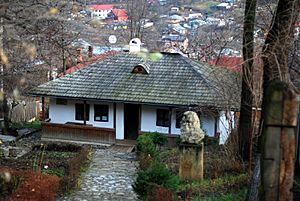
Iași is full of museums, memorial houses, and art galleries.
The first memorial museum in Romania opened in Iași in 1918. It was the Ion Creangă Memorial House. Today, the Iași National Museum of Romanian Literature has several memorial houses dedicated to famous writers like Mihai Eminescu, Vasile Alecsandri, and Mihail Sadoveanu.
The Union Museum has original items and documents that belonged to Prince Al. I. Cuza.
The Museum of Natural History was founded in 1834. It's the first museum of its kind in Romania and has over 300,000 items, including collections of insects, birds, and minerals.
Four other museums are located in the Palace of Culture:
- The Iași Art Museum is the oldest art museum in Romania. It has over 8,700 artworks.
- The Moldavia's History Museum has more than 48,000 historical objects.
- The Ethnographic Museum of Moldavia shows how Romanians lived through the ages.
- The Science and Technology Museum has over 11,200 objects related to science and technology.
In 2021, four new museums opened in the House of Museums: the Museum of Iași Pogrom, the Museum of the Jewish Theatre in Romania, the Museum of Poetry, and the Museum of Childhood under Communism.
Cultural Events: Festivals and Fun
Iași hosts many exciting cultural events and festivals:
- FILIT (International Festival of Literature and Translation): A yearly festival about books and translation.
- FIE (International Education Festival): A mix of cultural and educational events.
- International Theatre Festival for Young Audience: Held every October by the Luceafărul Theatre.
- SFR (Romanian Film Nights): Shows Romanian films and invites actors and directors.
- Afterhills: The biggest music festival in Moldavia, started in 2017.
- Hangariada: A festival about airplanes and art, held every May.
You can also find live music and other artistic events in the city's many bars and coffee shops.
Learning in Iași: Education
The first higher learning school in Romania was Academia Vasiliană, founded in Iași in 1640. It taught Latin and Slavonic languages. Later, in 1707, the Princely Academy was established.
In 1813, the first engineering class in Romanian was started by Gheorghe Asachi. In 1835, Academia Mihăileană was founded. It is considered the first Romanian higher education institute in the country.
In 1860, parts of Academia Mihăileană became the University of Iași, which was the first Romanian university.
Iași is also home to one of the oldest medical universities in Romania, founded in 1879. It is now called the Grigore T. Popa University of Medicine and Pharmacy.
In 1937, the engineering parts of the University of Iași became the new Gheorghe Asachi Polytechnic School. This school grew a lot and became known as Gheorghe Asachi Technical University in 1993.
Public universities in Iași include:
- Alexandru Ioan Cuza University: The oldest higher education institution in Romania.
- Gheorghe Asachi Technical University: Has the oldest engineering tradition in Romania.
- Grigore T. Popa University of Medicine and Pharmacy: One of the oldest medical schools in Romania.
- George Enescu National University of Arts: The oldest school for music and arts education in Romania.
- Ion Ionescu de la Brad University of Life Sciences: One of the oldest schools of its kind.
The Central University Library of Iași is the oldest and second largest library in Romania. It keeps important historical records.
Iași also has many public and private schools, including notable high schools like Iași National College (1828) and Costache Negruzzi National College (1895).
The Iași Science Festival is a yearly event in April. Students can observe and take part in science experiments and visit university labs. In 2014, over 10,000 students participated!
Sports in Iași
In 2012, Iași was chosen as one of the European Cities of Sport. The city also recently hosted the International Esports Federation (IESF) World Championships in 2023. Many countries from all over the world took part.
Current Sports Teams
| Sport | League | Club | Founded | Venue |
|---|---|---|---|---|
| Football | Liga II | FC Politehnica Iași (2010) | 16 August 2010 | Emil Alexandrescu Stadium |
| Basketball | Men's Liga I | CS Politehnica Iași | 1967 | Sala Polivalentă |
| Handball | Men's Divizia A | CS Politehnica Iași | Sala Polivalentă | |
| Rugby | Divizia Națională de Seniori | CS Politehnica Iași (rugby) | 1964 | Agronomia Stadium |
Getting Around: Transport in Iași
Public Transport: Trams and Buses
Iași has a good public transportation system run by CTP Iași. It uses 126 trams (electric trams started in 1900!) and 150 buses. In 2014, over 50 million passengers used public transport in Iași.
By Air: Iași International Airport
Iași is served by the Iași International Airport (IAS). It's about 8 km (5 mi) east of the city center. This airport is the 3rd busiest in Romania. It has direct flights to other cities in Romania, Europe, and the Middle East. The airport has grown a lot since 2015 after major upgrades.
By Train: Railway Stations
Iași has three railway stations: Grand Railway Station, Nicolina International railway station, and Socola railway station. These stations are operated by Romanian Railways. You can also travel to Moldova from here.
The Grand Railway Station is about 1 km (0.6 mi) from the city center. It connects Iași to all major Romanian cities and to Chișinău, Moldova. Trams and buses connect the stations to all parts of the city.
By Road: Driving to Iași
Iași is connected to Bucharest by European route E583/E85. It's also connected to Central Europe and Chișinău by European route E58. National roads link Iași to other major Romanian cities. A new motorway, the East-West Motorway (A8), is being built. It will connect Iași to the border with Moldova and to other major motorways in Romania.
The Iași Coach Station offers bus connections from Iași to many places across the country.
Monuments and History: Statues and Memorials
-
Independence Monument
-
Victims of Communism Memorial
Global Connections: Twin Towns
Iași is twinned with many cities around the world. This means they have special friendly relationships and often work together on projects.
|
|
Consulates in Iași
- Moldova – Consulate-General
Honorary Consulates:
- France
- Hungary
- Italy
- Pakistan
- Turkey
Famous People from Iași
Images for kids
-
Cuza Palace, now the Union Museum
See also
 In Spanish: Iași para niños
In Spanish: Iași para niños


